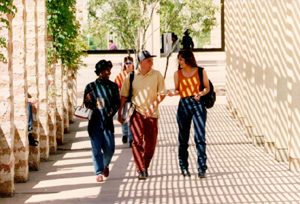
After five years of falling enrollment at Palo Alto College, enrollment
is on the rise and school administration is planning further improvement.
Enrollment increased by 4 percent from 6,382
Despite the increase in enrollment, Palo Alto still remains behind two other Alamo Community College District schools, San Antonio College and St. Philip’s College, in terms of funding.
Palo Alto received $8,792,808 for the 2001 fiscal year, September 2000 thru August 2001. That is $21,528,837 less than San Antonio College, and $6,148,928 less than St. Philip’s in total state funding.
Money given to the school largely depends on the total amount of contact hours generated for a regular 16-week semester. A 3-hour academic course will generate 48 contact hours over 16 weeks. A 3-hour technical or vocational course, which also requires a 1-hour lab, generates 64 contact hours.
According to the 2000-2001 Palo Alto College Fact Book, 5,309 students enrolled in academic courses, 773 students enrolled in occupational and technical courses and 300 students took academic and occ-tech courses concurrently.
Much of the disparity in state funding can be attributed to the funds given to the occupational and technical courses that cost more to operate.
Palo Alto offers nine occupational and technical courses, where St. Philip’s offers numerous courses on everything from the Culinary Arts to Automotive Technology.
“That is definitely one area we are trying to expand,” said Ginger Hall Carnes, Director of Community & Public Relations. “The reason why occupational and technical courses receive so much money from the state is because it is very expensive to provide and maintain the supplies needed for these type of courses.”
One goal for Palo Alto’s new president, Dr. Ana “Cha” Guzmán, is to increase academic enrollment by 3 percent annually, according to a handout passed out at the Faculty Senate/Staff Council Forum on Oct. 17, 2001.
“One area we are trying to expand and enhance is our evening offerings,” said Stacey Johnson, Interim Dean of Arts & Humanities.
The idea of improving enrollment takes time and planning. “Extensive schedule analysis is necessary and important in order to improve enrollment,” said Pat Terrell, Assistant to the President. “We are going to schedule more wisely by offering students more availability for the most requested courses and increase marketing to reach out to the community.”
The growth of enrollment may continue next semester because of Sept. 11, 2001, and the effects of a slowing economy and job layoffs.
“When times are tough and the economy is struggling, many displaced workers will return to school to improve their status in the job market,” said Carnes.